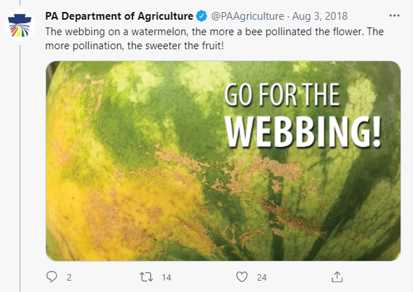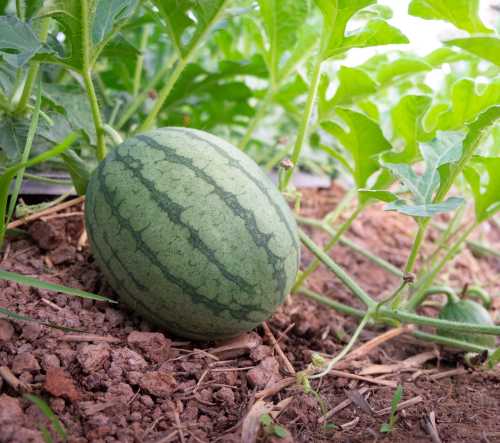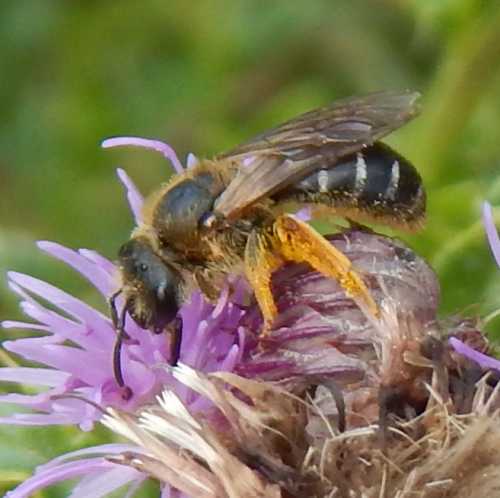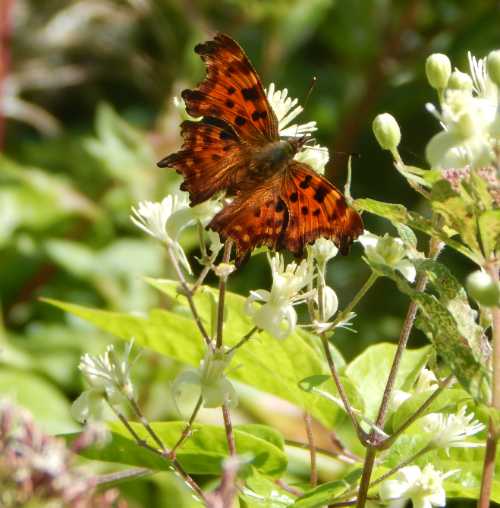Do Bees Sting Watermelons, And If So, Why?
Is there truth in the idea that bees cause markings (scratches or webbing) on watermelon flesh (through stinging or pollination) and that this indicates sweetness?
When I received a query regarding watermelons and bee stings, it provoked a whole investigation:
Question:
I read that to choose a watermelon that's really sweet, we need to look out for bee stings on the outer flesh. Please can you explain to me why bees sting watermelons?
- Courtney, USA
The short answer is:
There is no evidence that bees sting watermelons and cause a mark on the outer flesh that signifies sweetness. However, it may be that pollination by bees affects the sweetness of watermelons.
Now for the detail ...
Do Bees Actually Sting Watermelons, And Does This Indicate Ripeness And Sweetness Of Fruit?
I was intrigued by this query, and after doing a little digging, I found there were two main theories floating around the web:
1. Bees cause marks on watermelons
Firstly, there's an old wives tale that we should look out for marks left by bee stings on watermelons because it indicates ripe fruit. I could not think of any reason why bees would sting fruit - and this would automatically exclude males, since they cannot sting in the first place.
2. Pollination by bees results in marks on the watermelons
The second idea states that we should look out for webbing marks on the outer flesh of the water melon, as these are a result of pollination by bees, and the more webbing marks found, the sweeter the watermelon.
I even came across a tweet from Pennsylvania Department Of Agriculture. There are a number of watermelon growers in Pennsylvania (I counted 531 but this figure refers to 2016, and may be out of date).
 Are marks on watermelons caused by bees, and do they suggest a sweeter watermelon?
Are marks on watermelons caused by bees, and do they suggest a sweeter watermelon?The tweet suggests a link between webbing markings on fruit, greater pollination levels and sweeter fruit. But is this just marketing, or simply an incorrectly informed tweet from a social media marketer? Where did the social media marketer seek out their information?
Checking claims about bees, watermelons, and sweetness
The USA is the 7th largest producer of watermelons, according to the organisation representing growers, that is the National Watermelon Promotion Board2 . This means there are multiple sources of official information available over the web.
In particular, I decided to look for
- scientific research to support the claims made,
- official advice and data for watermelon growers on insect and bee pollination of watermelons, from key grower organizations and agricultural advice bodies
- scientific and official advice on watermelon ripeness indicators, diseases, and factors for sweetness.
My reasoning was that if markings on watermelons indicate sweetness, and if those markings are caused in some way by bees (whether by pollination, or bizarrely, bee stings) then the growers and the organizations and bodies that advise them, will certainly know about it and will be talking about it somewhere.
A summary of findings
Through my investigations I have found:
- no evidence to suggest a link between the markings on watermelon fruit, and bees.
- no evidence specifically linking 'webbing' marks on water melons and sweetness levels.
- however, a lack of pollination may help to result in more bitter, misshapen fruit.
- it appears there is a link between sweetness of watermelons and pollination by bees, but this has nothing to do with bees stinging the watermelons, nor resultant markings on the fruit.
- there are visual clues that a water melon is ripe and sweet, but these markings have nothing to do with bees.
Now I'll expand on each of the points above.
No evidence linking bee stings and watermelon sweetness

It's clear that farmers rely on bee pollination in order to successfully grow watermelons, and it seems that pollination by bees results in sweeter watermelons, however, this has nothing to do with bees stinging the fruit.
Evidence links pollination and watermelon sweetness
There is evidence that links pollination by bees with watermelon sweetness.
An article from the University of Delaware states that following successful pollination by bees, cells in the watermelon fruit divide to give the potential fruit size, after which, cells expand and fruit enlarges as sugars accumulate. This may imply a link between the sweetness of watermelons and pollination by bees.
This is perhaps no surprise, as similar connections have been made with other fruits. For example, studies have directly demonstrated a link between bee pollination and fruit sweetness in apples.
Lack of pollination by bees can result in mis-shapen and bitter fruit
The University of California (David) Vegetable Research And Information Centre produced a document in which they outline a problem diagnosis for watermelons.
Notably, they state that lack of pollination can result in low fruit set, bitterness and misshapen fruit. (Lack of sweetness may also be down to soil quality). Bitterness is the opposite of sweetness, so it would seem that the absence of bee involvement could result in bitter fruit.
From the document2:
| What The Problem Looks Like | Probable Cause | Comments |
|---|---|---|
| Poor fruit set | Insufficient pollination Lack of bee pollinators | Hand-pollinate using artist's paintbrush if you have too few bee pollinators. Bee activity may be low due to cool weather or insecticides. |
| Misshapen or bitter fruit | Inadequate pollination Dry soil or high temperatures Poor soil fertility | See comments above. Supply water. Get soil tested. |
| Poor flavor Lack of sweetness | Poor soil fertility Low potassium, magnesium or boron. | Get soil tested and adjust fertilizer. |
The University of California also commented2:
"POLLINATION
One to two bee colonies per acre should be placed in
the field when male flowers begin to appear. Poor pollination often causes misshapen fruit. ...
Care must be taken to prevent the bee
colonies from being exposed to pesticides."
Do 'webbing' marks relate to pollination by bees?
I can find no scientific evidence, nor guidance for growers suggesting that webbing on the flesh of watermelons is related to pollination by bees.
Nevertheless, The National Watermelon Promotion Board provides advice on selecting a watermelon2:
- Look the watermelon over. Select a watermelon free from bruises, dents, cuts. They state that scratching on the outer flesh may occur during handling, but this is acceptable.
- A watermelon is 92% water, therefore, we should select a heavy watermelon.
- Check for a creamy yellow spot on the flesh of the watermelon. This is where the watermelon sat on the ground, ripening in the sun.
It is notable that they don't mention anything about webbing marks caused by bees as an indicator of sweetness, yet we could surely expect them to add this to their advice if it were the case.
Likewise, an expert from Purdue University and former plant pathologist, Daniel Egel, has outlined a number of tips on selecting watermelons for ripeness4 (and hence sweetness). In particular, he advises:
- A watermelon that is ripe will be faded on the top. If the watermelon has stripes, look at the area between the stripes. This area should be a light green.
- Where the fruit stood on the ground (he calls it the 'belly spot'), will be white or yellow if the watermelon is ripe. If the stripes are visible through the belly spot, the watermelon may not be ripe.
- Avoid a lumpy watermelon. Smooth rind usually indicates a good fruit.
- Melons with pointy ends may still be maturing and not ripe.
- If you listen closely and flick your finger at the fruit, an unripe watermelon will 'ping' whereas an overripe watermelon will 'thud.' Select one that is somewhere in between.
Again, it's notable that there is no recommendation to look for webbing marks or black dots as signs of pollinator activity (especially bee stings) and ripeness.
References
1. Pennsylvania Wholesale Watermelon Growers, 2016 https://www.paveggies.org/wp-content/uploads/Pennsylvania-Wholesale-Watermelon-Growers.pdf
2. National Watermelon Promotion Board https://www.watermelon.org/about-us/
https://vric.ucdavis.edu/pdf/MELON/watermelon.pdf
3. WATERMELON PRODUCTION IN CALIFORNIA https://anrcatalog.ucanr.edu/pdf/7213.pdf
4. Changing of the gourd: Ripe watermelon has telltale signs; Purdue news August 2008.
https://www.purdue.edu/uns/html4ever/000714.Egel.watermelon.html
5. Joshua W. Campbell, Cory Stanley-Stahr, Mary Bammer, Jaret C. Daniels & James D. Ellis (2019) Contribution of bees and other pollinators to watermelon (Citrullus lanatus Thunb.) pollination, Journal of Apicultural Research, 58:4, 597-603, DOI: 10.1080/00218839.2019.1614271
If you found this page helpful or interesting, I'd really be grateful if you would share it with others - if not this page, perhaps another, such as Gardening For Bees.
Thank you so much :) .

